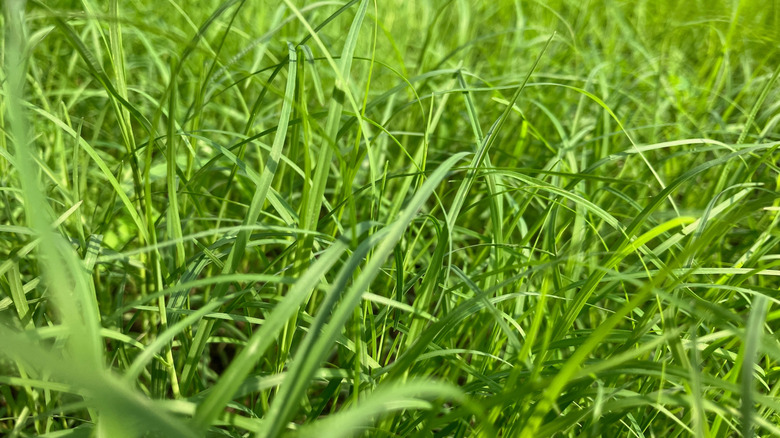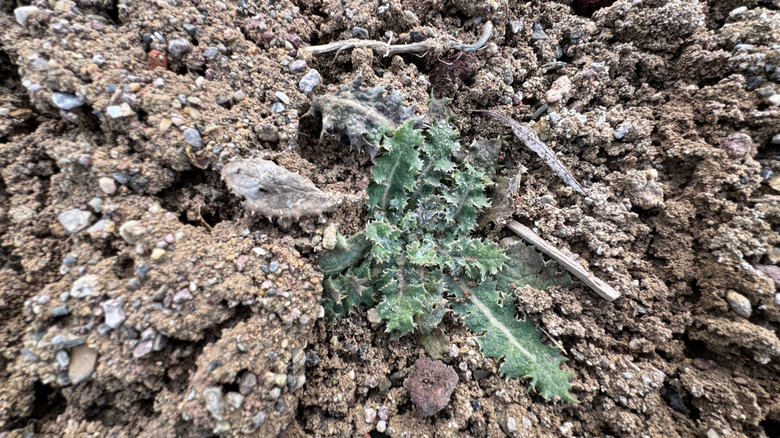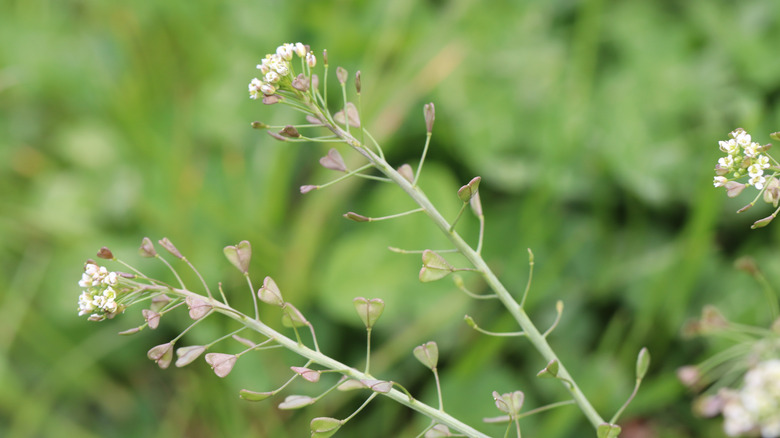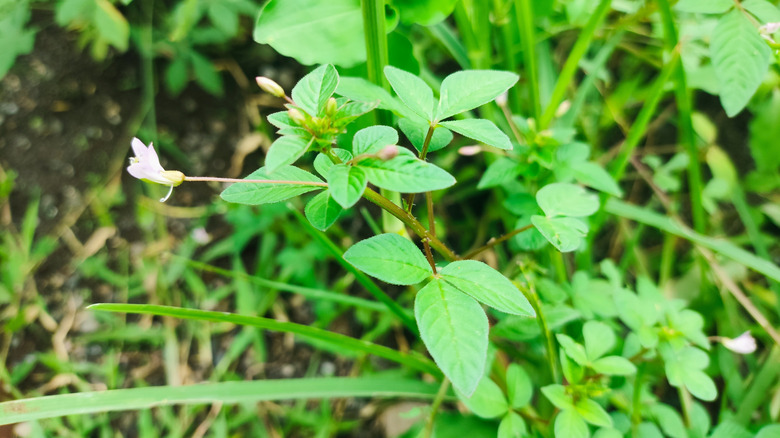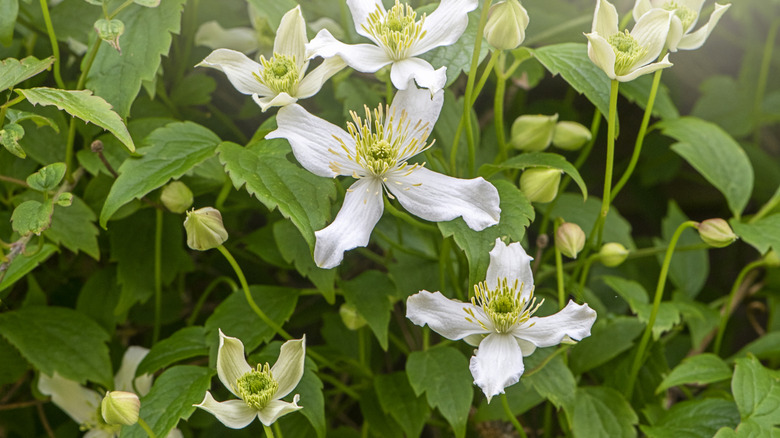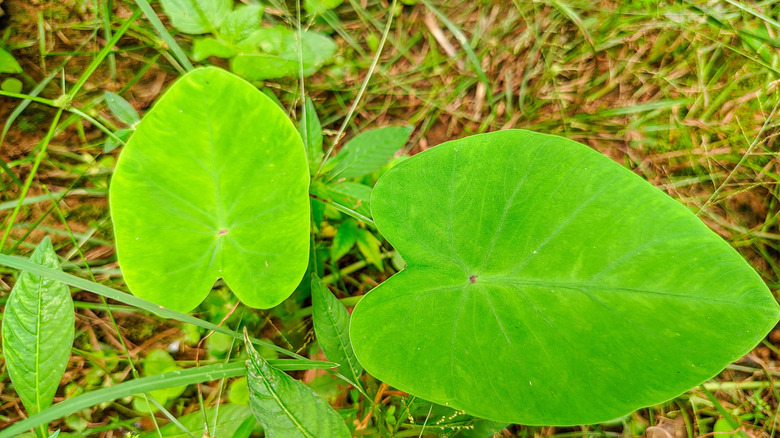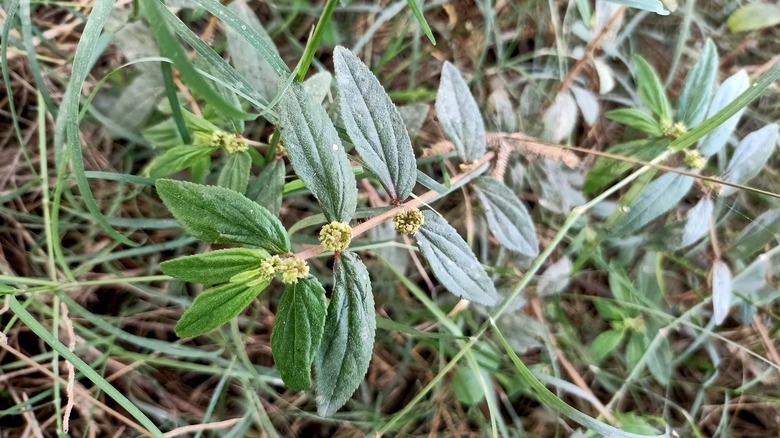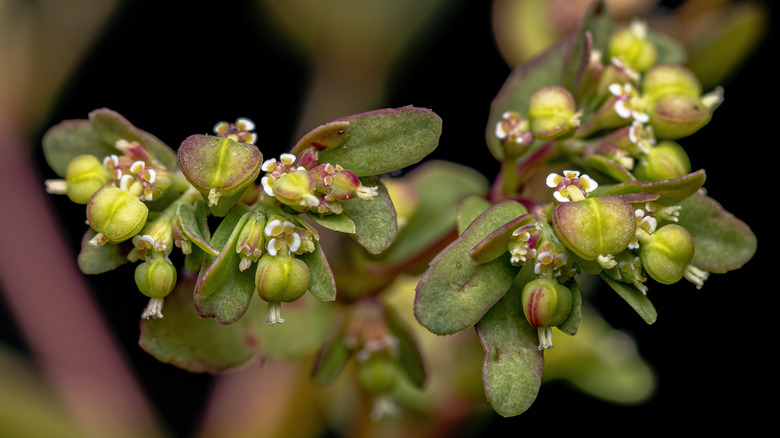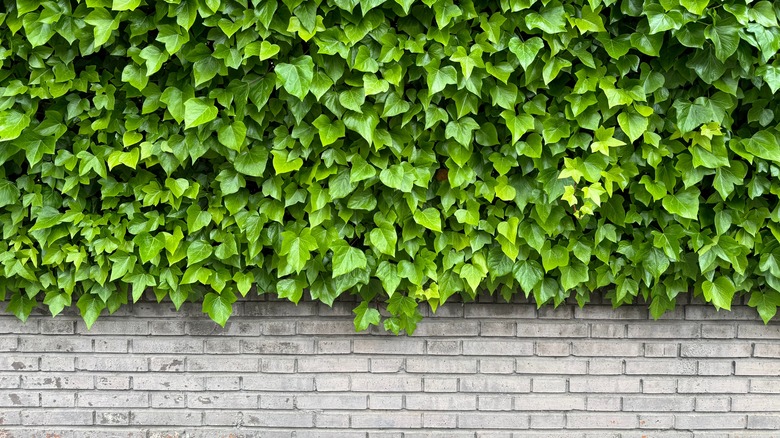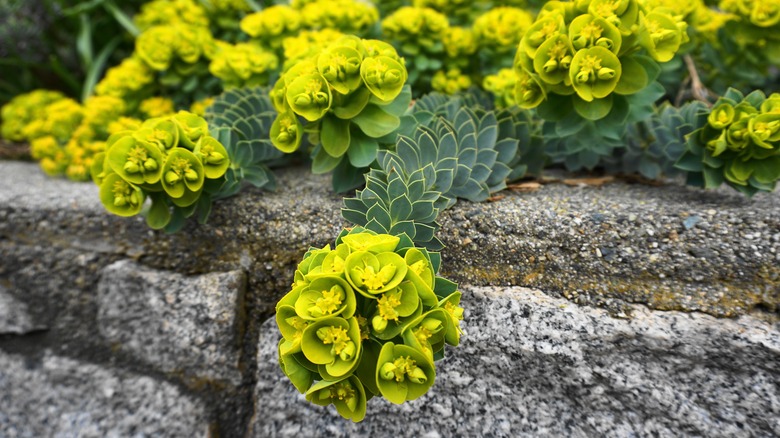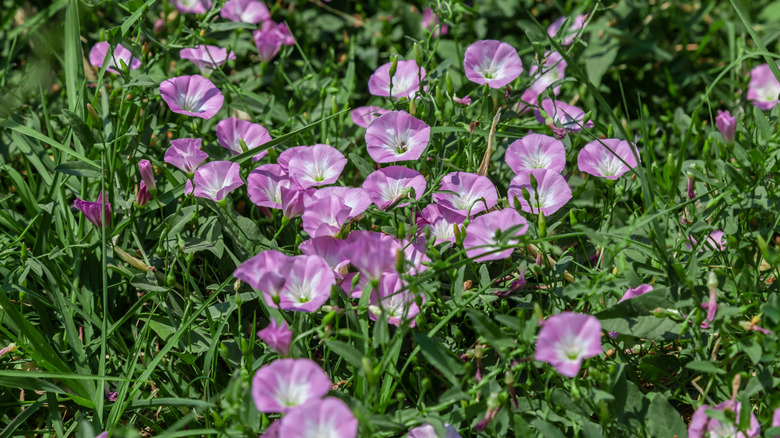11 Common Types Of Weeds That Are Attracting Pests To Your Yard
We may receive a commission on purchases made from links.
Weeds aren't just an annoyance in your yard and garden; some also have the ability to attract pests, too. Aphids, scale, whiteflies — they're all looking for a place to crash, and that dense mat of weedy vines or tall grass looks like a great home to them. But pests can get their own sense of wanderlust and start looking around your outdoor space for new areas to infest, like your beloved plants and trees. Before you know it, a small weed problem can turn into a full-blown pest infestation, threatening the health and beauty of your landscape.
So without wasting any time, let's talk about the 11 common types of weeds that can also turn into pest magnets. We'll cover what the weeds look like so you can differentiate them, and talk about which pests love them the most. Knowing your enemy is half the battle, and this guide will help you identify and eliminate those pest-harboring weeds, keeping your yard healthy. So, grab your gardening tools and let's reclaim your outdoor space — one weed at a time!
Bermuda grass attracts white grubs
Bermuda grass (Cynodon dactylon) is sometimes used as a turfgrass but can become a real headache in gardens. It grows in dense thatches with extensive root systems that make it a haven for white grubs. Once grubs get established, the damage they cause can result in thinning patches, brown spots, or even dead areas of grass. Plus, grubs are tasty morsels to certain predators like moles and skunks, which are most likely not the neighbors you were hoping to invite into your yard for snacks. You might also see different types of leaf-destroying caterpillars — armyworms, webworms, and cutworms, in particular — in addition to root-eating nematodes and mole crickets.
Bermuda grass looks like your standard grass that you might see on a golf course fairway – lush, green, dense mats of foliage. It spreads quickly via rhizomes underground and can be hard to completely get rid of thanks to its ability to handle heat, salt, and drought. However, it doesn't tolerate shade well, so you may want to try mechanical control options that deprive it of sun and warmth, such as shading it out in borders with large, fast-growing plants, or covering infested areas with tarpaulins. The grass might still grow under these conditions but should be at least weaker and easier to pull out. For areas where manual removal is difficult, you can also try a targeted herbicide like Ornamec or the BioAdvanced Bermudagrass Control For Lawns.
Sowthistles attract aphids
Sowthistle (Sonchus oleraceus) is a common weed that both greenhouses and landscapes have to deal with. While it's typically considered an herb, we and many exhausted gardeners see it as nothing but a nuisance that grows aggressively and re-seeds itself like nobody's business. Inside its stems is a milky sap that is a dietary delight for aphids. Once aphids descend onto the plant they'll begin to form large colonies that milk the weed for all its worth. Once the colony has destroyed the plant they'll begin looking for a new food source — and your garden could be next.
Sowthistle, with it's yellow flowers and fleshy long leaves, is a dandelion look-alike which you should remove from your lawn immediately, ideally before it blooms and produces seed. Although it shares many characteristics with dandelions, sowthistle grows taller and has slightly spiked leaf edges. If these pesky weeds are not annoying enough as-is, they've got a cousin, spiny sowthistle, which has prickly leaves that will probably just enrage you even further. Most sowthistles are annuals, however, there are a few varieties that are perennials. Since its primary method of spreading is via reseeding, you'll most likely only need to deal with isolated plants which can be easier than rhizome-connected colonies. Your best bet for stopping the spread is to pull out plants (which isn't too hard, as they have a shallow taproot) before the seeds can get carried by wind. If seeds have already spread through your garden, and you decide to go with chemicals, shoot for pre-emergent types for maximum effectiveness. For an organic post-emergent option, you can also experiment with using vinegar to kill thistle weeds — but we'd recommend horticultural strength for sowthistle.
Shepard's purse attracts aphids, beetles, and leaf miners
Shepard's purse (Capsella bursa-pastoris) may look harmless with its dainty heart-shaped leaves, but it's a menace to any place it's planted. Not only is it a weedy species that's hard to get rid of, but it can play host to multiple garden pests. Aphids, curculio beetles, and leaf miners are all attracted to shepard's purse and can establish large colonies quickly. If that's not enough to irritate you, any of its seeds that happen to land in water become mosquito magnets. But the mosquitoes will end up getting stuck to the seeds instead of buzzing around your face, so thanks for that, we guess.
Shepard's purse grows to around two feet tall in ideal conditions and spreads via seeds that germinate in spring and fall. Self-seeding plants may seem like they're easily controlled as compared to rhizome-spreading ones, but shepard's purse is highly adaptable and found in climates all over the world. If you'd like to give it a second life once you've cleared it from your plot of land, the leaves, shoots, and seeds are all edible and used for salads or, in the case of seeds, as a flavoring agent that can substitute for ginger. While you can try weeding by hand, this pesky plant has a deep and stubborn taproot. If you're unable to get it out by the root, using a combination of pre- and post-emergent herbicides are two other ways you can handle shepard's purse in your lawn and prevent it from releasing its seeds.
Bittercress attracts whiteflies and mites
Bittercress (Cardamine) is a genus of plants that is found around the world. They're highly adaptable and can host aphids, whiteflies, and mites in addition to several plant diseases. Bittercress is part of the mustard family and some consider this an ornamental plant or will grow it for culinary reasons. However, don't let that fool you; many parts of the world list this family as an invasive species.
The bittercress family contains over 200 different plant species so finding similarities in their appearances isn't easy. Generally speaking, you'll want to look for standalone plants that have small, white or blush-pink flowers. Their leaves can range from thin and tapered, like the cut-leaf species (Cardamine concatenata), or flat and paddle-shaped, like the New Zealand bittercress (Cardamine corymbosa). Most bittercress species spread via seeds. Herbicides and hand weeding are the two primary removal methods, and you should work quickly to prevent the plant from blooming and releasing its seedpods.
Japanese clematis is a haven for aphids and vine weevils
It's truly a tragedy that Japanese clematis (Clematis terniflora) is on this list, because it's so pretty and smells incredible. Yet this aggressive grower is considered an invasive species in multiple states around the U.S. and can harbor aphids and vine weevils. We've already covered the damage aphids do, but vine weevils are new to the list so let's talk about how they'll harm your plants. Vine weevils are little nocturnal beetles that will take small bites out of leaves as an adult, affecting the look of the plant more than its health. Their true destructive behavior happens during the larvae stage where they live underground and feed off of plant roots. What's worse is they're nearly impossible to control because their larvae are so small and live underground.
Japanese clematis is a vine with dainty, white flowers and thin leaves. Once it gets established this plant, like weevil larvae, is almost impossible to control. It spreads via seed, layering, and runners, effortlessly climbing over other vegetation and smothering it. Eradicating this vine will take serious effort thanks to its vigorous growing habit and multiple methods of spreading, so you may want to consider matching its aggression with your control methods. The best time to remove Japanese clematis is during winter when the plant is dormant. You will need to cut off the stems, thoroughly dig out the roots, and dispose of the waste in a way that it won't regrow (do not try to compost or chip it into mulch). Regrowth is common, so be on the lookout for any shoots and snap them off. Alternatively, you can apply an herbicide containing triclopyr (like Alligare Triclopry 4) to the cut stem to prevent regrowth.
Chinese yam attracts scale and mealybugs
The Chinese yam (Dioscorea polystachya) was originally grown for its edible tubers but has become another menacing vine that stamps out other plants and brings along friends, too. It's able to attract several pests who are looking for an easy meal, but scale insects and mealybugs are particularly big fans. Both are sap-sucking pests that will ride Chinese yam's fast-growing vines, hopping from one plant after sucking its sap to move onto another. Both also have the ability to secrete a type of sticky honeydew that attracts ants and black sooty mold, just to add another bummer to your day.
Chinese yam can stretch its vines over 11 feet and uses both its tubers and seeds to spread. It has slightly elongated, heart-shaped leaves that look almost like a young Monstera deliciosa leaf before fenestration. Rather than trailing itself with long, thin vines, Chinese yam likes to completely overtake whatever it touches and cover it with a dense mass of vines, similar to how English ivy grows. To manually eradicate the plant, you must remove all of its tubers from the ground and check for regrowth. Missed tubers are capable of resprouting for up to seven years. Herbicides are also an option, but you'll probably have to go in with the big guns, like a triclopyr-based product.
Garden spurge attracts aphids, spider mites, and mealybugs
Garden spurge (Euphorbia hirta), sometimes also known as the hairy spurge or, terrifyingly, the asthma plant, is a survivor. This weed can grow almost anywhere, trailing its hairy stems to wherever it can take hold. It's also a sap-producing plant that attracts the infamous sap-suckers already featured on this list: aphids and mealybugs. However, it'll also draw in a different type of sucker pest, spider mites. Spider mites don't suck sap from the stem but the contents of a leaf's cell structure. While a few spider mites most likely won't kill a mature, healthy plant, a large enough colony certainly can kill annuals.
Garden spurge has relatively thick, reddish-brown stems that are covered with tiny hairs and elongated, narrow leaves. In between opposing leaves is a cluster of flowers that have a brown or pink hue. This plant is an absolute menace to deal with, growing quickly and spreading via seeds that it can produce in the thousands every few months. Garden spurge can live in most soil conditions and has been found in every lighting condition from full sun to full shade. Hand pulling is one of the best ways to remove garden spurge from your yard so it doesn't take over, just be careful that you get the root out, as stems have a tendency to break off. Soil solarization (a practice that can keep away both weeds and pests) is another method you can try. Mulching can help stop existing seeds from germinating, and pre- and post-emergent herbicides can assist to nip outbreaks in the bud.
Hyssopleaf sandmat is a haven for spider mites and aphids
Most often found in the South, hyssopleaf sandmat (Euphorbia hyssopifolia) is a sprawling weed that thrives in hot climates. This unassuming weed, often found in dry, sandy soils, can become a haven for tiny sap-sucking creatures like aphids, mealybugs, and spider mites. Hyssopleaf sandmat can spread quickly thanks to the prolific flowering while plants are still young, becoming hotels for pests avoiding the hot summer suns.
Hyssopleafs have bright red stems and elongated, narrow leaves that only grow around the nodes. It stays relatively small, only growing around 18 inches tall, but puts its clusters of flowers right on top. Once those flowers open up, get ready, because it will bloom throughout the summer and release seeds that have no dormancy period, growing its colony faster than you'd think. Hand weeding and chemical methods are recommended for controlling this weed, though you should try to act before it flowers and opt for pre-emergent herbicides for the best results.
English ivy is host to a wide spectrum of pests
When you think of English ivy (Hedera helix) you might envision an old Tudor-style home with at least one façade completely covered in bushy greenery. But English ivy isn't a romantic plant that adds old-world charm, it's an incredibly aggressive vine that will damage buildings and play host to an entire world of bugs and critters. Most notably, caterpillars, mealybugs, aphids, mites, scale, and loopers like to call it home. Caterpillars and loopers both eat foliage and can stunt a plant's growth with their damage. Add in English ivy's "take no prisoners" growth strategy and weakened plants will hardly stand a chance. When grown as a groundcover, English ivy can also provide convenient hiding spots for mice and other rodents.
English ivy has wide, tri-pointed leaves and long vines that can reach as much as 80 feet in length. During its juvenile phase where it's focused on growing as quickly as possible, English ivy looks a little wiry with its big, green leaves and long stems. Once it's established, the vines will move into their adult phase and begin to fill out, gaining its famous bushy appearance. It may also produce clusters of white flowers and blue or black berries, which are poisonous. To remove this not-so-romantic pest, you can start with pulling it out by hand (just be sure to protect your skin) or mowing over prostrate areas. When new growth emerges, you can also try chemical control by applying a triclopyr-containing herbicide to the young leaves (which will be more vulnerable to it, having not yet developed a strong waxy coating), and after sawing off bigger vines, apply herbicide right onto the cuts.
Myrtle spurge can attract aphids and mealybugs
Vines don't get to have all the fun; succulents can get weedy, too. The myrtle spurge (Euphorbia myrsinites) is one such succulent, though it has mixed reviews. In most parts of the world, it's considered an ornamental plant but in the western United States, it's only thought of as a noxious weed. This drought-tolerant plant can grow over rocky, sandy soils and become a haven for aphids, mealybugs, and the aptly named leafy spurge flea beetle. Since it forms a dense foliage mat, it creates the perfect home for tiny pests that want to stay hidden as they grow their colonies and feed.
Myrtle spurge looks a little like a long, green-colored pinecone with blue-green leaves that spiral around the stem. The end of each stem holds a cluster of yellow-green flowers where the fruits form which eventually release its seeds. Myrtle spurge can self-seed freely and has actually been known to chuck its seeds as far as 15 feet from the flower. To remove, wearing protective clothing and eye protection (as the sap is poisonous), pull up plants by the base, aiming to get as much of the taproot out as possible. You will invariably leave some behind, and several follow-up pullings are generally needed. As soon as you see a baby myrtle spurge popping up in the same spot, pull it! If you want to try an herbicide, but this pesky plant is growing amongst desirable species or turfgrass, then you can try a selective herbicide containing 2,4D.
Bindweed can attract gall mites and thrips
Bindweed is often mistaken for a morning glory, but it's more like a distant cousin. Unfortunately, it didn't inherit many good qualities from its cousin as bindweed is an aggressive grower that's notoriously almost unkillable and home to thrips. Thrips are winged pests that puncture a plant's leaf and suck out its cells' contents, weakening more delicate plants and stunting their growth. They rarely completely destroy a plant, especially if it's a more substantial tree or shrub, but young plants and crops can sustain serious damage that's hard for them to recover from.
Bindweed has three common species that are considered weeds: Field bindweed (Convolvulus arvensis) and hedge bindweed (Convolvulus sepium) have trumpet-shaped flowers and pointed leaves with a single notch, while black bindweed (Fallopia convolvulus) has heart-shaped leaves and nearly-inconspicuous flowers. Convolvulus species have extensive root systems digging as much as 30 feet down and will spread via seeds. Black bindweed is a little easier since it's an annual and doesn't have as intricate a root system so you may be able to just use mechanical means. Small plants can be successfully dug out, but established specimens can easily regrow from small root pieces left in the soil. To prevent this, you can try cutting the vines off at the base, repeating as they grow back until the energy stores in the rhizomes run out — or paint the stem with an herbicide. If you opt to dig out the roots, be prepared to follow up every few weeks and spade out pieces that regenerate. Convolvulus does have a biological control (the bindweed gall mite), but it is not widely available and can require permits to purchase and transport across state borders.

